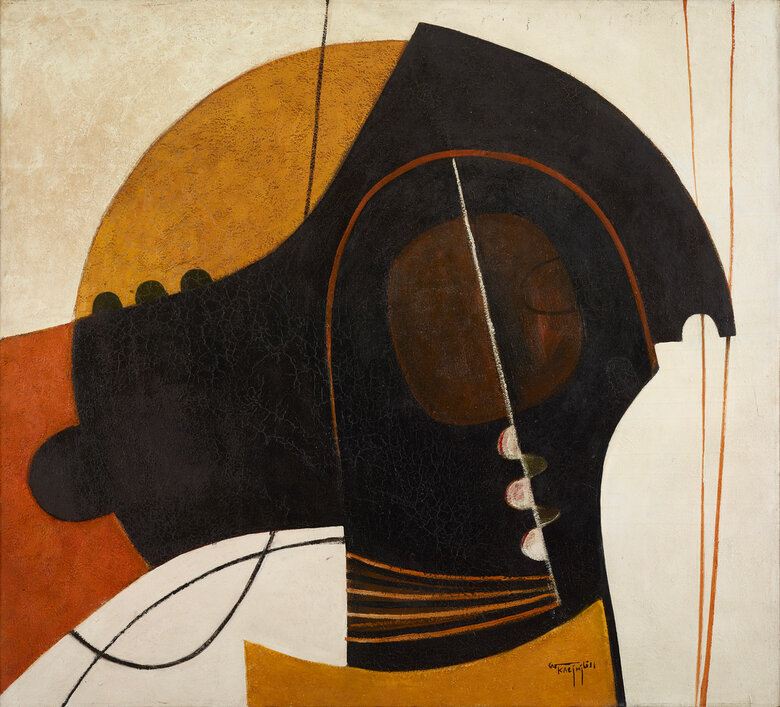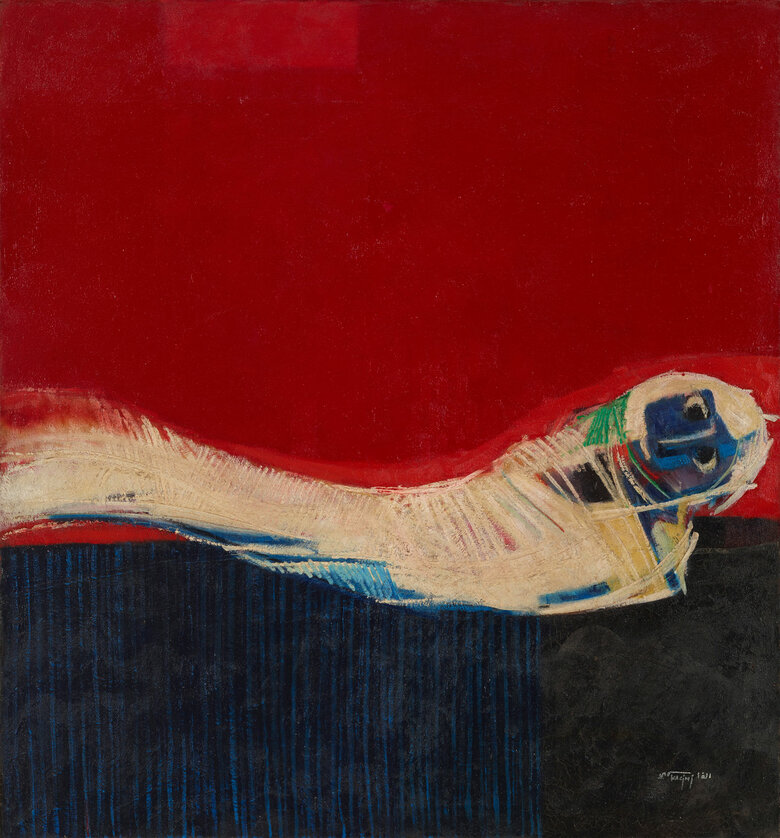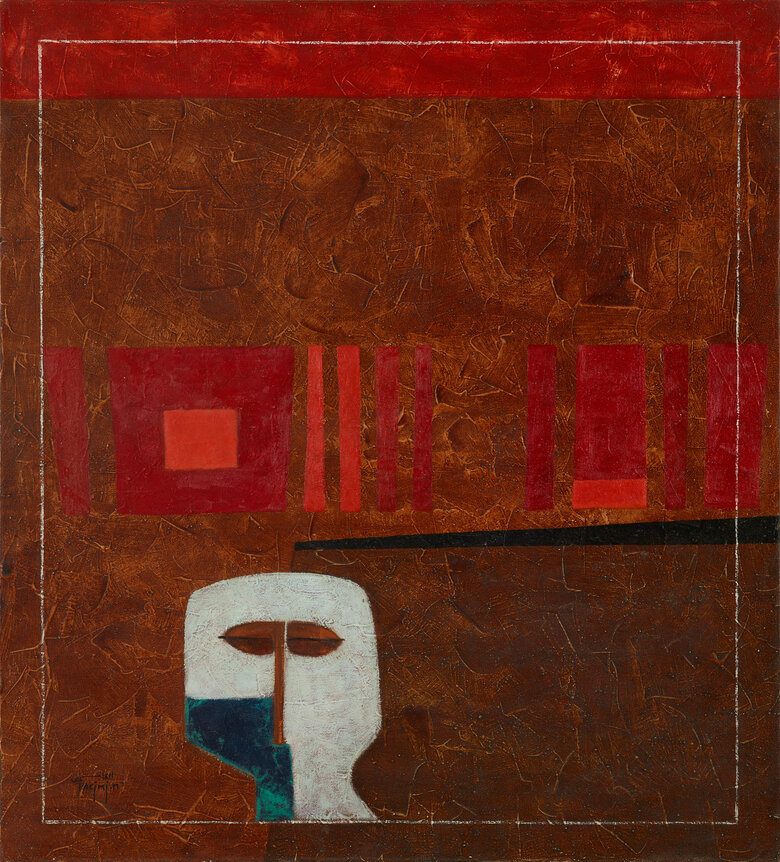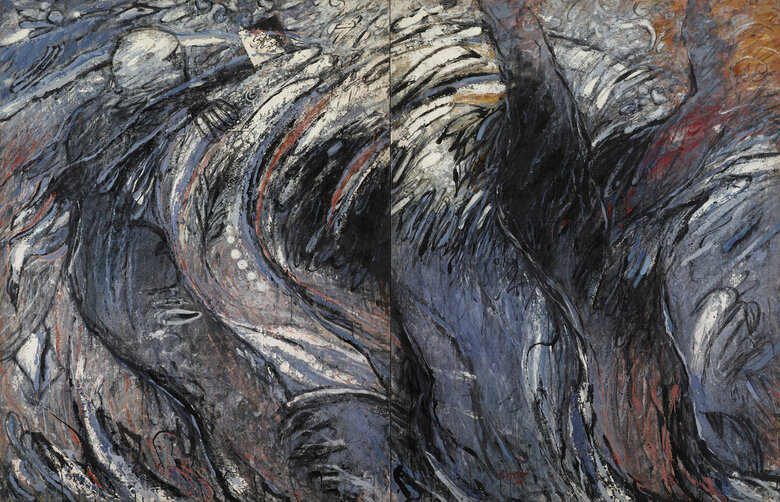Untitled, 1993, is a large-scale painting that depicts an abstracted figuration. In the foreground, we see the likeliness of a human figure painted with thick masses of titanium white and shady grays; it is set on the right side of the painting’s vertical composition. Although the human figure is abstracted, one can discern its body's facial features, core, and extremities. The background reveals a harmonious amalgamation of dark tones against lighter ones; it features deep shades of brown, copper, and indigo blue, highlighted with scattered patches of muted white to create a sense of mysticism. Kacimi skillfully accumulated the acrylic paint layers onto the canvas, creating a rich texture and solid blocks of muted colors. At the lower right corner, an enigmatic bottle-like shape resembling that of an inkwell is surrounded by black circles. Delicate, thin dark lines traverse the brown clusters of color in the foreground, adding a sense of movement and intrigue.
The central figure in the foreground commands attention. It is distinct in shape: elongated and stands tall front-facing with a rugged head and strong-lined nose. These robust features add character and definition to the abstracted figure. The upper part of the ‘human’ form is brightly highlighted with shades of white and gray that form the shoulders standing firm and straight. Draping around the figure's waist are red vertical brushstrokes reminiscent of a Moroccan 'djellaba.' Looking further down the composition, the legs painted in hazy gray extend – yet their contours are defined. Notably, the feet face opposite sides, offering a subtle suggestion of dynamic tension. Meanwhile, the arms remain unfinished, creating an intriguing interplay of completion and incompleteness.
Nestled behind the figure to the right, an oval form emerges. Mirroring the face of the subject in an evocative and haunting expression, its positioning creates a distant perspective. Within the contours of the oval form, an obscure face takes shape, characterized by drooping, dark-set eyes, and subtle features. The colors echo the background tones without a hint of copper, allowing it to camouflage into its surroundings.
An indigo-colored offset shape hovers in the lower right corner of the painting, placed at the subject's feet. It resembles an inkwell yet retains an air of ambiguity. Angular in its composition, this enigmatic shape captivates the gaze. Saturated with color at its edges, the ‘inkwell’ gradually intensifies in brightness towards the center, generating a dynamic visual effect. It is topped with what appears to be a lid in shades of brown and black outline.
Contrasting the subject and positioned closer to the foreground, a squared canvas stands in the lower left corner. Painted in muted shades of white, gray, and brown, the canvas also portrays another undefined human figure. The figure, seen in profile, exudes a youthful essence with its delicate features, including a rounded nose and a short jawline. Thick hair, depicted through dark, rounded brushstrokes, cascades from the figure's head, adding texture and visual interest to the composition. Moreover, the top of the painted canvas is adorned with elements reminiscent of Arabic calligraphic writings and Berbers tribal signs, evoking a sense of cultural heritage and artistic fusion.
Mohamad Kacimi's artistic journey was informed by his time in Europe and Paris in particular. It encompasses diverse artistic movements, such as Tachism or abstract expressionism. Having lived in the coastal town of Harhoura-Temara in 1979, the Atlantic Sea became a profound source of inspiration for Kacimi. It is precisely reflected in Kacimi’s recurrent use of indigo blue, better known as 'Kacimi's blue.'
Moreover, Kacimi’s explorations in the deserts of Morocco and the caves of the Atlas Mountains during the 1990s, alongside his fascination with the ancient civilization of the Amazigh (Berbers) and their cave art, further influenced his artistic vision. Integrating Moroccan cultural traditions, including textiles, pottery, and calligraphy, Kacimi employs a bold color palette and abstract forms, skillfully navigating the interplay between cultural hybridity, Islamic art, and contemporary art.
In Untitled, 1993, Kacimi strategically positions the human figure as the focal point of his artwork, inviting a dialogue with the audience. By omitting distinct clothing, gender, age, and temporal context, the figures become vulnerable and delicate, carrying an unsettling undertone. The subdued color palette intensifies neutrality, facilitating a connection between the viewer and the painting. The deliberate choice of unfinished arms and indistinct images is a hallmark of Kacimi's style. They add an intriguing layer of ambiguity, allowing the viewer to participate in completing the narrative of the artwork.
Simultaneously, Kacimi’s stylized and abstracted forms push the boundaries of traditional art, creating a visual language that embraces intersectionality and encapsulates the complex experiences of marginalized or underrepresented individuals. References to documentation through the depiction of the inkwell, the calligraphic scribbles, and the canvas are common motifs Kacimi uses to reflect the difficulty of migration. This exploration might reflect Kacimi's nomadic background and cultural experiences.
In conclusion, Untitled, 1993, with its masterful interplay of colors, forms, and cultural references, offers a captivating exploration of identity, tradition, and artistic fusion. The harmonious amalgamation of deep shades and meticulous details in the background creates a textured tapestry that sets the stage for the emergence of this captivating abstracted human figure. Mohammed Kacimi pushes the boundaries of traditional art, offering a visual language that reveals a profound exploration of identity, cultural hybridity, and the human condition.
Signed in Arabic and English on the lower right front

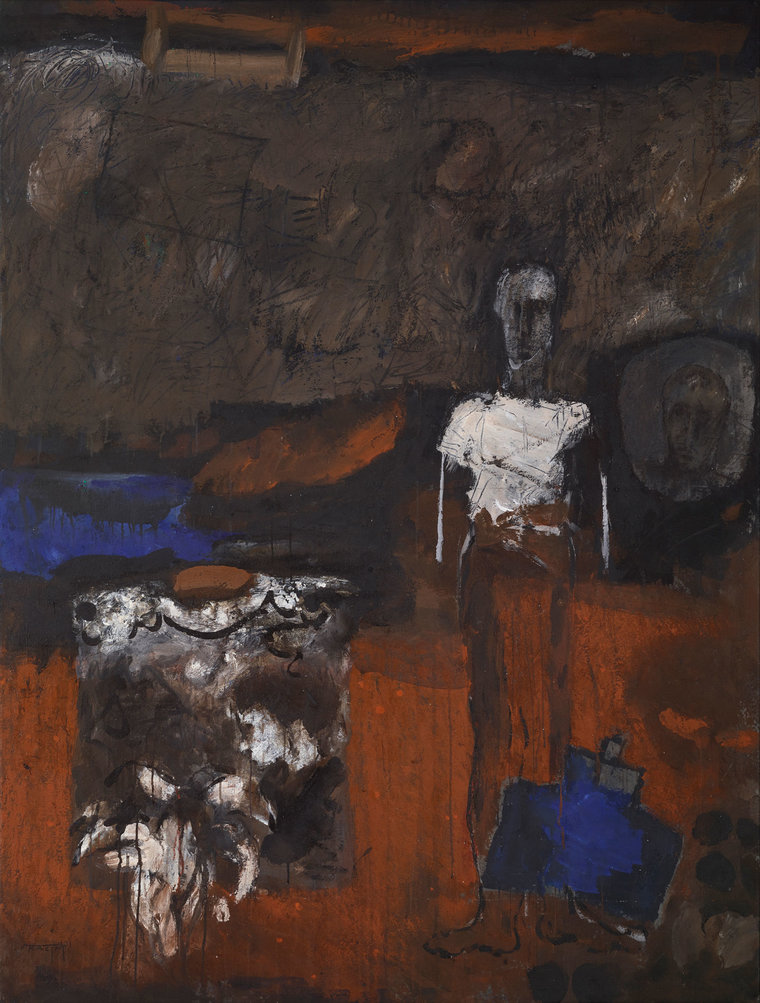

-Front.jpg)
-Front.jpg)
